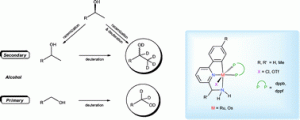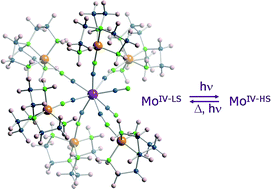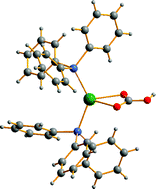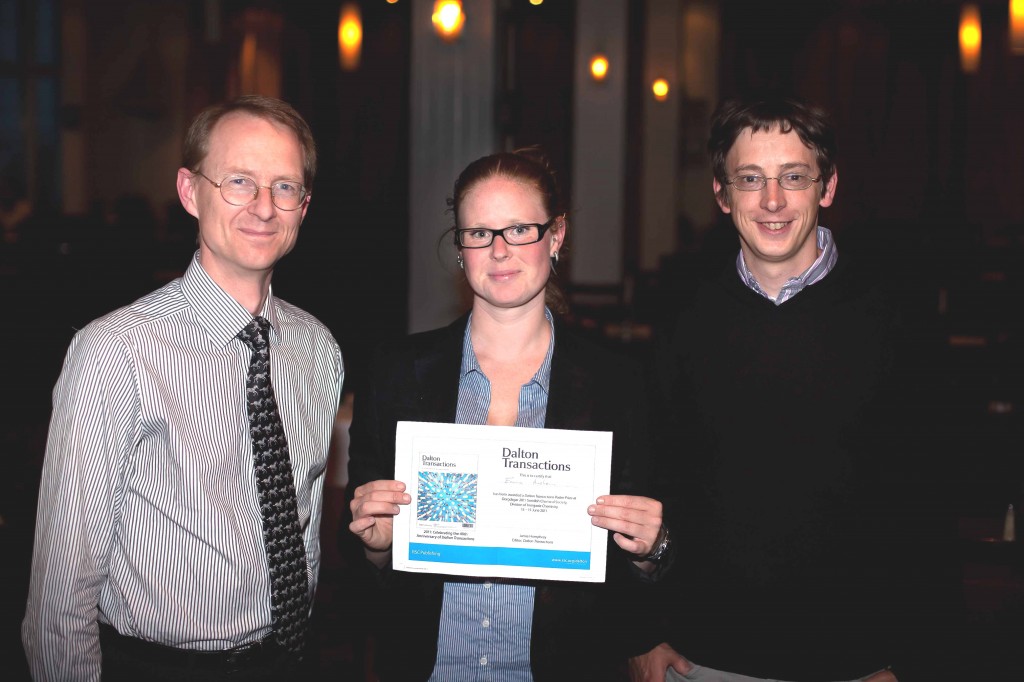 Walter Baratta and colleagues describe the first examples of osmium catalysts used for the racemization and deuteration of alcohols. The group found that diphosphine based pincer complexes based on ruthenium and osmium are are efficient catalysts for the racemization of secondary alcohols and also efficiently catalyze the deuteration of both primary and secondary alcohols.
Walter Baratta and colleagues describe the first examples of osmium catalysts used for the racemization and deuteration of alcohols. The group found that diphosphine based pincer complexes based on ruthenium and osmium are are efficient catalysts for the racemization of secondary alcohols and also efficiently catalyze the deuteration of both primary and secondary alcohols.
Read their HOT article to find out more. This article is free to read for four weeks.
Pincer Ru and Os complexes as efficient catalysts for racemization and deuteration of alcohols
Gianluca Bossi, Elisabetta Putignano, Pierluigi Rigo and Walter Baratta
Dalton Trans., 2011, Advance Article DOI: 10.1039/C1DT10498E
This paper will feature in the forthcoming Pincers themed issue appearing soon – guest editors Professors Gerard van Koten and Bert Klein Gebbink. Look out for the issue when it is published later this summer!















 In this HOT article, the authors have extended their work in understanding enantioselective catalysis by coordination compounds. The role of steric hindrance in controlling the binding mode of propylene oxide to a novel vanadyl salen-type complex N,N‘-bis(5-tert-butylsalicylidene)-1,2-cyclohexanediamino-vanadium(IV) oxide, [VO(3)], has been investigated using CW/pulse EPR, ENDOR and HYSCORE spectroscopy and compared to that of the parent complex N,N‘-bis(3,5-di-tert-butylsalicylidene)-1,2-cyclohexanediamino-vanadium(IV) oxide, [VO(1)]. Removal of the ‘inner tert-butyl groups from the salicylidene rings reduces the steric hindrance between the ligand and epoxide substrate. As a result the selectivity for binding single enantiomers of propylene oxide in these complexes is reversed in [VO(3)] relative to [VO(1)].
In this HOT article, the authors have extended their work in understanding enantioselective catalysis by coordination compounds. The role of steric hindrance in controlling the binding mode of propylene oxide to a novel vanadyl salen-type complex N,N‘-bis(5-tert-butylsalicylidene)-1,2-cyclohexanediamino-vanadium(IV) oxide, [VO(3)], has been investigated using CW/pulse EPR, ENDOR and HYSCORE spectroscopy and compared to that of the parent complex N,N‘-bis(3,5-di-tert-butylsalicylidene)-1,2-cyclohexanediamino-vanadium(IV) oxide, [VO(1)]. Removal of the ‘inner tert-butyl groups from the salicylidene rings reduces the steric hindrance between the ligand and epoxide substrate. As a result the selectivity for binding single enantiomers of propylene oxide in these complexes is reversed in [VO(3)] relative to [VO(1)]. In this HOT article, the molecular structures of 1,2-closo-P2B10H10 (1) and 1,2-closo-As2B10H10 (2) have been determined by gas electron diffraction and the results obtained compared with those from computation at the MP2/6-31G** level of theory. The first examples of metalladiphosphaboranes and a considerable extension of the range of known metalladiarsaboranes, these compounds being prepared from deboronated derivatives of 1 and 2, respectively, are also reported.
In this HOT article, the molecular structures of 1,2-closo-P2B10H10 (1) and 1,2-closo-As2B10H10 (2) have been determined by gas electron diffraction and the results obtained compared with those from computation at the MP2/6-31G** level of theory. The first examples of metalladiphosphaboranes and a considerable extension of the range of known metalladiarsaboranes, these compounds being prepared from deboronated derivatives of 1 and 2, respectively, are also reported. A N^N Pt(II) bis(acetylide) complex containing coumarin was prepared in this Dalton Transactions Hot article.
A N^N Pt(II) bis(acetylide) complex containing coumarin was prepared in this Dalton Transactions Hot article. The most stable crystal structures of different TCN compounds are investigated in this Dalton Transactions Hot article.
The most stable crystal structures of different TCN compounds are investigated in this Dalton Transactions Hot article.